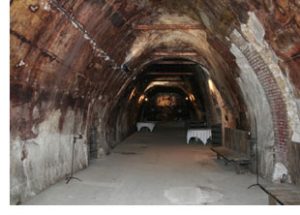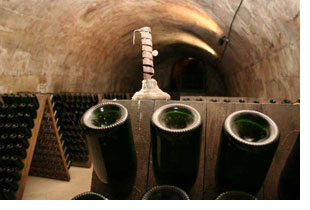by Justin Jangraw
 A bubbly liquid runs through the veins of the French in the Champagne-Ardennes province and the heart pumping it is Reims. Reims is the epicenter of Champagne production for the world. In fact, Champagne worldwide is only created in this small French province. Anything else is sparkling wine.
A bubbly liquid runs through the veins of the French in the Champagne-Ardennes province and the heart pumping it is Reims. Reims is the epicenter of Champagne production for the world. In fact, Champagne worldwide is only created in this small French province. Anything else is sparkling wine.
The province of only 1.3 million people produces over 45 million bottles of Champagne most years. Two thirds of these are exported across the globe, the remaining stay in France. Of those bottles that stay in France, a third of them never leave the Champagne-Ardennes province. That’s a large alcohol content for a little over one million happy men, women, and children.
My wife, her parents, and I joined in the constant Champagne fueled celebration over a long weekend stay in Reims. Even Sunday nights along the pedestrian zone ring with sounds of toasting glasses and French conversation.
In early October over 40,000 locals vacate their regular jobs in the cities and move into the vineyards. They work alongside thousands of travelers and migrant workers to pick the grapes for the year’s harvest.
Tradition and local law enforce that Champagne grapes are picked by hand to avoid breaking the skin on Pinot Noir and Pinot Meunier (dark) grapes. This ensures that all Champagne will maintain its clear color when bottled.
For centuries, the harvest has been a time of celebration in the Champagne-Ardennes region. Villagers gather in the vineyards to pick grapes while refreshing themselves with bottles of prior years’ harvests. Every night is a celebration worthy of a bottle of Champagne.
Luckily, the locals welcome out-of-towners to help with the picking. Travelers can work in the vineyards for a modest wage and full accommodation during the season. The work is extremely hard labor and often for long hours. However, with one or two liters of wine to maintain the mood you will finish with a few good stories, better French, and a few Euros in your pocket.
Before electricity and climate controlled rooms, storing wines for long periods of time was a bit more difficult. In fact, you had to dig a cave; a huge one, under your property. In and around the Champagne-Ardennes there are over 250 kilometers of these tunnels and man-made caves.
Our favorite is Champagne Martel G.H. & Cie which operates a small set of caves. This Champagne House is few blocks away from the tour bus circuit and boasts a more intimate experience.
 The tour through the caves was informative and also interesting – an odd mix. The House treated the three of us to a private tour. The walk and three sample glasses of Champagne cost less than a beer at the local pub. Each of us walked away with a general understanding behind the bottling and history of Champagne. Further, it’s a cheap way to taste a few moderately expensive glasses of Champagne.
The tour through the caves was informative and also interesting – an odd mix. The House treated the three of us to a private tour. The walk and three sample glasses of Champagne cost less than a beer at the local pub. Each of us walked away with a general understanding behind the bottling and history of Champagne. Further, it’s a cheap way to taste a few moderately expensive glasses of Champagne.
Renting a bike is an excellent way to see the real Champagne region. More rugged travelers often follow the “Route Touristique du Champagne” through every village between Reims and Epernay.
It is about 35 hilly miles to Epernay while coasting and cursing through the beautiful vineyards along the Montagne de Reims. From Epernay the route continues along the Marne River all the way back to Paris by way of three more 35 mile legs which weave through Chateau-Therry and Meaux.
Each small town offers its own special attractions and many places to rest for the night. Maps and other information on the “Route Touristique du Champagne” are available from most Tourist Information centers in the area. The information desk outside of the Notre-Dame Cathedral in Reims can supply you with a map.
The Drouet d’Erlon Square in the center of Reims is the heart of the city. Notre-Dame is only a short ten minute walk away and the large pedestrian zone square is full of outdoor cafes and small hotels.
After a day of wine tasting, relaxing in an outdoor café along the Drouet d’Erlon Square is a perfect conclusion. Compared to most European cities, hotels along the square are relatively cheap.
We stayed at the Hotel Continental located directly on the square within thirty seconds of ten different cafés and across the street from a public parking garage. The hotel has three stars but the comfort is first class and the location is splendid.
For dinner, we always stayed close to the hotel. Any of the numerous cafés along the street offer fine menus and great people-watching. Remember, the French eat dinner late, so if you are looking for a meal at five or six all of the tables may be empty; but they should still serve.
 On a Sunday night, the tables began filling up around 8 or 9. After a full course meal and three bottles of wine, we discovered it was past midnight, on a Sunday, and the Square was still packed with locals and a few tourists.
On a Sunday night, the tables began filling up around 8 or 9. After a full course meal and three bottles of wine, we discovered it was past midnight, on a Sunday, and the Square was still packed with locals and a few tourists.
The Champagne-Ardennes region of France offers many attractions not seen by your average traveler. If you are a tired tourist in Paris looking for a few days break, a roughneck adventurer looking for a nice bike trip, or a wine connoisseur looking to experience Champagne at its home; Reims is a pivotal stop on any French journey.
About the author:
Justin Jangraw a freelance travel writer/photographer who currently lives in Germany..
The photos by Justin Jangraw:
1: Inside one of the tradional caves used for champagne storage
2: Champagne bottles stored top down.
3: A corner of the building showing the Martel sign.